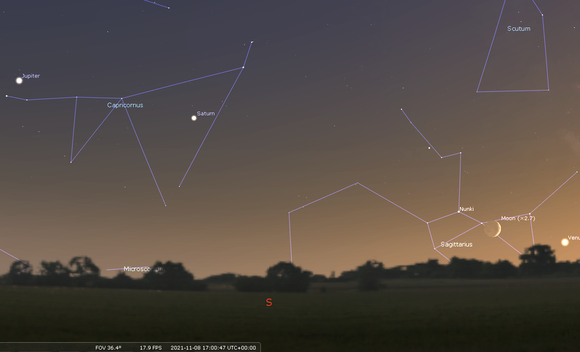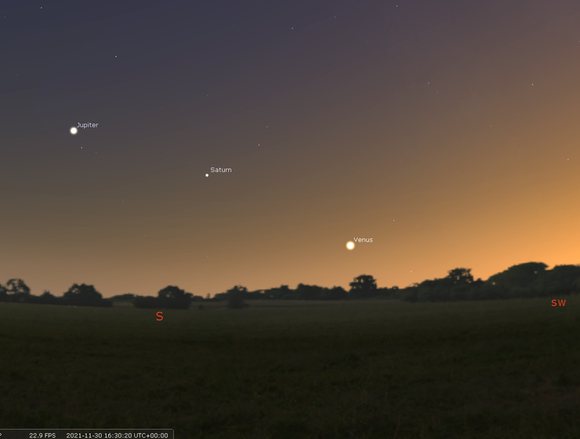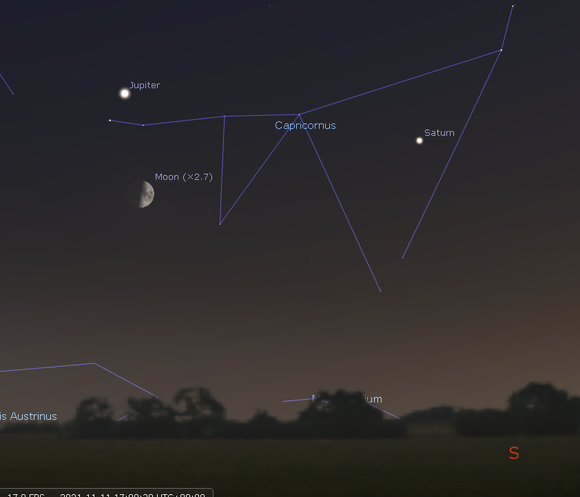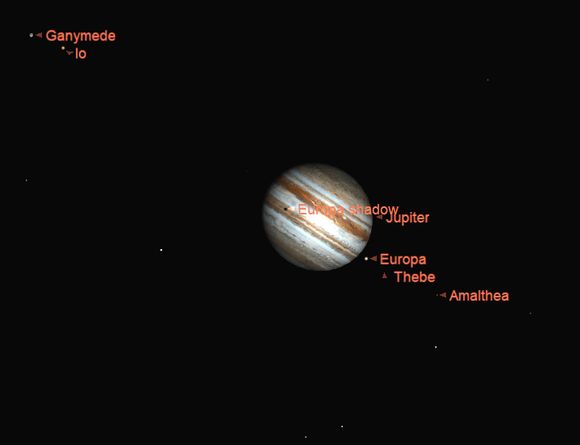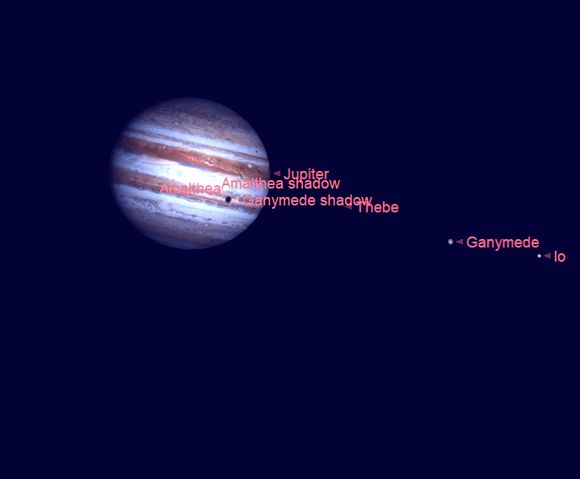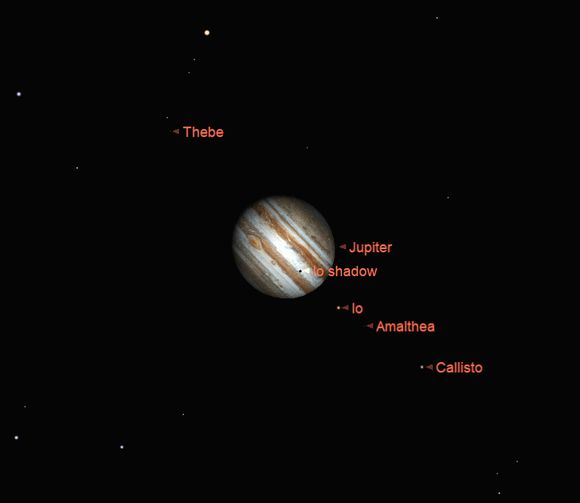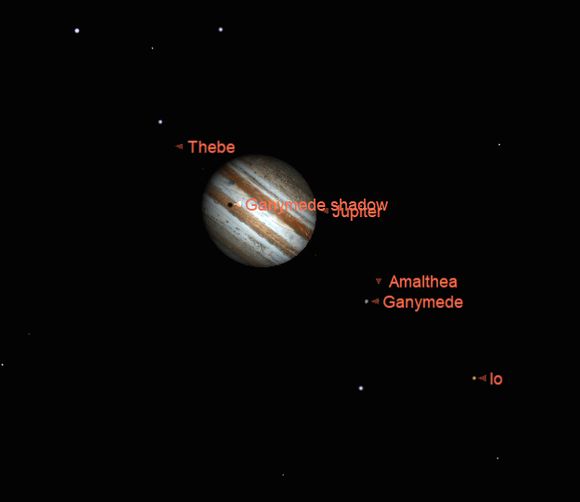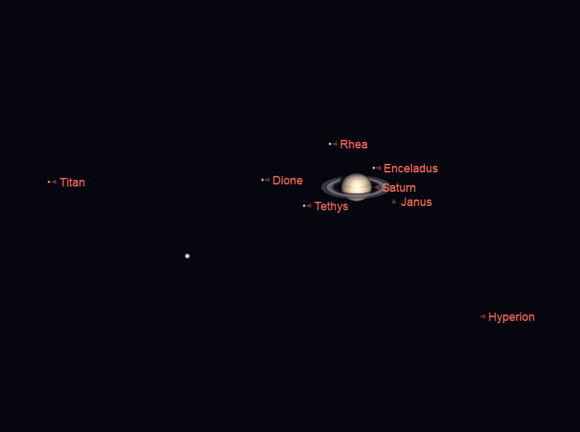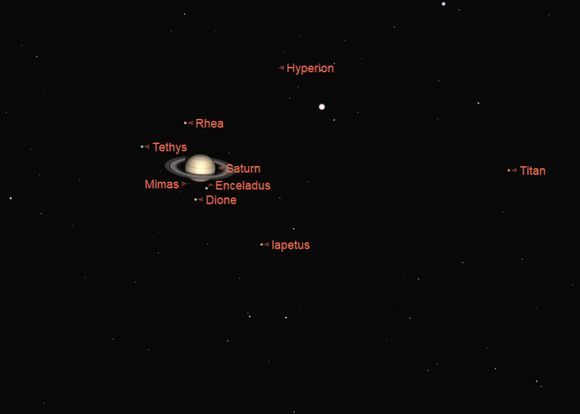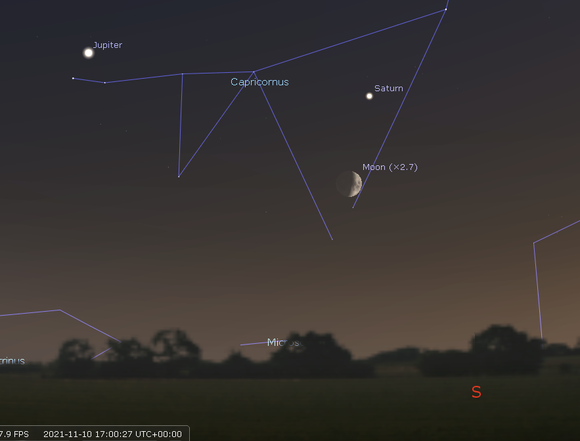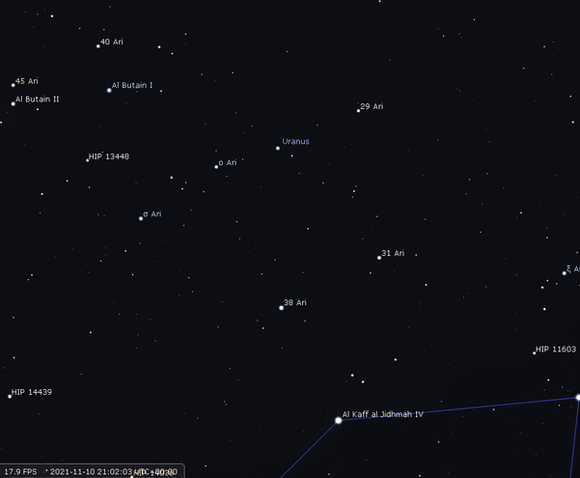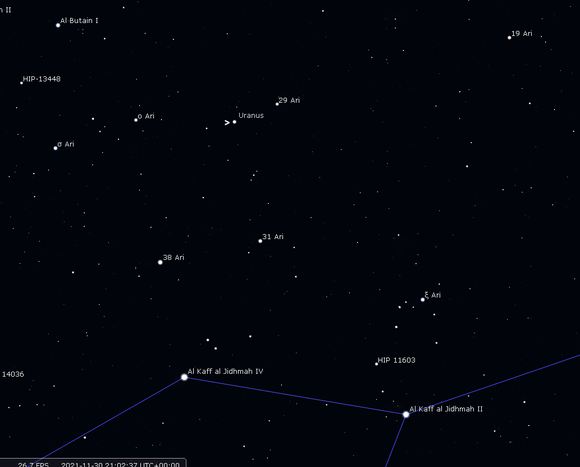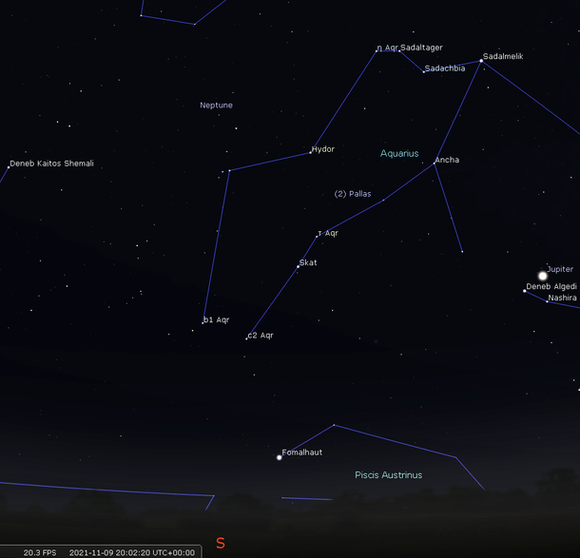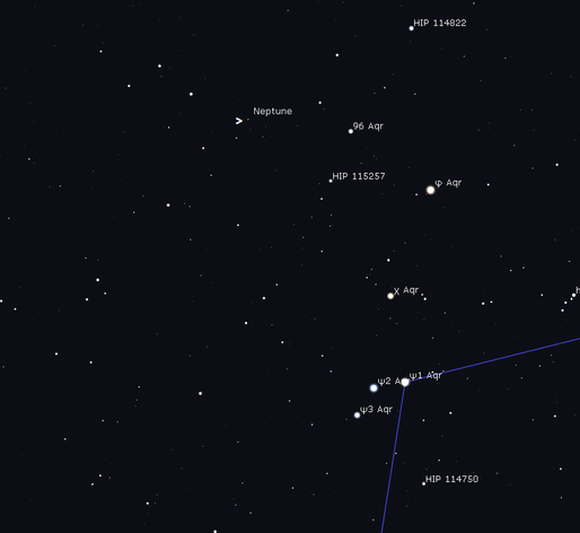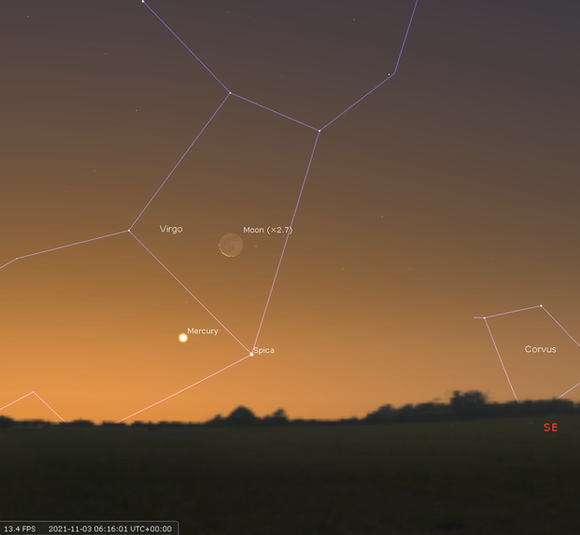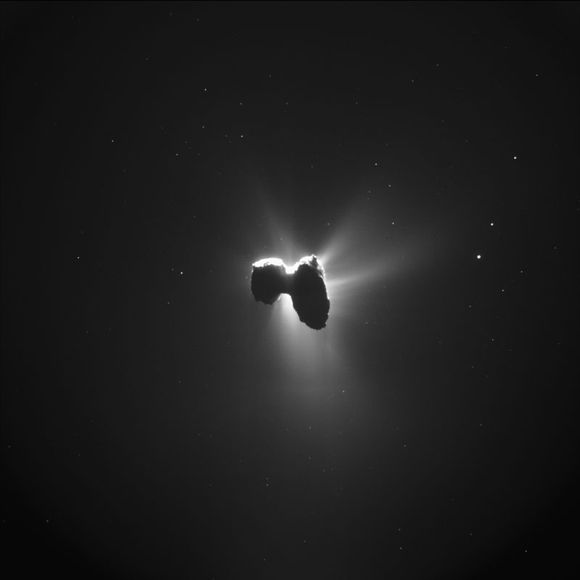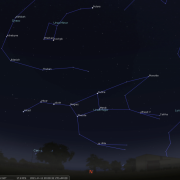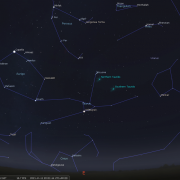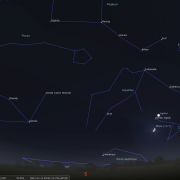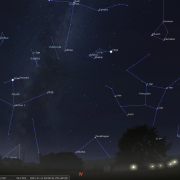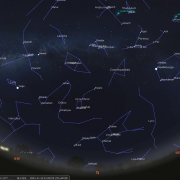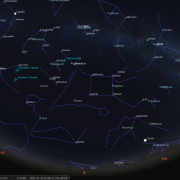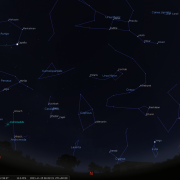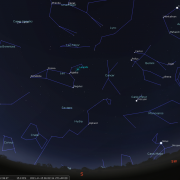In this month's Sky Notes:
Planetary Skylights - Brief
 If you have an unobstructed SW aspect, look for Venus low to the horizon around 30-40 minutes after sunset. At magnitude - 4.3 Venus should be readily visible, but this brilliance is tempered somewhat by the low altitude and lighter sky conditions present. If possible view on the 7th and 8th between 16:30hrs and 16:45hrs to spot a very young crescent moon. On the 7th it will be more difficult to spot, residing to the lower right of Venus. The following evening the moon will reside upper left of Venus and will be easier to spot, but there will be barely 20 minutes in which to do so. Throughout November careful observations of Venus approximately half an hour after sunset each day, will reveal that Venus is very slowly gaining in altitude above the SW horizon and heading in the direction of Saturn and Jupiter. Given the low altitude, the image of Venus is naturally very poor in the eyepiece, even the phase is hard to distinguish; a waxing gibbous.
If you have an unobstructed SW aspect, look for Venus low to the horizon around 30-40 minutes after sunset. At magnitude - 4.3 Venus should be readily visible, but this brilliance is tempered somewhat by the low altitude and lighter sky conditions present. If possible view on the 7th and 8th between 16:30hrs and 16:45hrs to spot a very young crescent moon. On the 7th it will be more difficult to spot, residing to the lower right of Venus. The following evening the moon will reside upper left of Venus and will be easier to spot, but there will be barely 20 minutes in which to do so. Throughout November careful observations of Venus approximately half an hour after sunset each day, will reveal that Venus is very slowly gaining in altitude above the SW horizon and heading in the direction of Saturn and Jupiter. Given the low altitude, the image of Venus is naturally very poor in the eyepiece, even the phase is hard to distinguish; a waxing gibbous. November 8th 17:00hrs GMT
(click for full image)
 Currently residing in western Capricornus Jupiter remains the most dominant planetary object in the night sky at magnitude -2.5 and is visible to the south as dusk falls. It culminates at a respectable 23 degrees above the horizon, just about clear of the turbulent air lower down, thus allowing close scrutiny with a telescope. Jupiter is now in prograde motion once again; moving west to east against the background stars. The Moon sits lower left of Jupiter on the 11th.
Currently residing in western Capricornus Jupiter remains the most dominant planetary object in the night sky at magnitude -2.5 and is visible to the south as dusk falls. It culminates at a respectable 23 degrees above the horizon, just about clear of the turbulent air lower down, thus allowing close scrutiny with a telescope. Jupiter is now in prograde motion once again; moving west to east against the background stars. The Moon sits lower left of Jupiter on the 11th.
Through the eyepiece Jupiter is a magnificent sight, with plenty to interest all levels of observing experience. The bright disk is over 40 arc seconds across and is noticeably oblate, with banding across it. If seeing is good a certain amount of subtle colouration is apparent. Jupiter is flanked by the Galilean moons' seen as specks of light close by. Look for the Great Red Spot (GRS) feature, an ever present storm which over the last decade has diminished in size and colour intensity, but may now be re-establishing itself. The GRS can be seen on Jupiter from 18:00hrs and before 20:00hrs on the following dates; November 3, 5, 7, 10, 12, 17, 22, 24, 29th.
Regular observers of the Jovian system will note the 'dance' of the Galilean moons around Jupiter, throwing up a different configuration each night. The four major moons are visible in 10x50 binoculars as specks of light, small scopes won't reveal a great deal more. If you have a 4" (100mm) aperture scope' and above, shadow transits of moons passing on the near side of Jupiter will be visible, jet black dots of varying size dependant on which moon is involved. The actual moons themselves are more difficult to spot as they pass in front of Jupiter, requiring much larger apertures. The most favourable shadow transits this month are on the following dates and times. Io - 7th @ 19:00hrs; 14th @ 19:30hrs & 30th @ 18:30hrs. Europa - 1st @ 20:15hrs. Ganymede - 9th @ 17:45hrs & 16th @19:45hrs
 For UK observers Saturn is ideally placed in the evening sky above the SSW horizon as soon as darkness falls. It will then be at a respectable height equating to 20 degrees. Residing a good hands span ahead of Jupiter amongst the stars of west Capricornus, Saturn appears quite conspicuous with an apparent magnitude of +0.5. The magnificent ring system is orientated with the North Pole tilted toward Earth by almost 17 degrees. This angle is slowly closing up with respect to Earth taking another 4 years before we arrive at the next ring plane crossing event.
For UK observers Saturn is ideally placed in the evening sky above the SSW horizon as soon as darkness falls. It will then be at a respectable height equating to 20 degrees. Residing a good hands span ahead of Jupiter amongst the stars of west Capricornus, Saturn appears quite conspicuous with an apparent magnitude of +0.5. The magnificent ring system is orientated with the North Pole tilted toward Earth by almost 17 degrees. This angle is slowly closing up with respect to Earth taking another 4 years before we arrive at the next ring plane crossing event.
In the eyepiece Saturn remains a glorious sight and although Saturn is twice as far away as Jupiter, the disk size of 18.5 arc is very respectable, especially when you factor in the rings. A scope with an aperture of 80-100mm (3.5-4") will reveal the two brightest rings; ring A (the outermost) and ring B. These are separated by the Cassini Division. Ring C lies closest to the disk and is more difficult to spot, especially when 'seeing' is unsteady, normally requiring scopes of 150mm (6"). Saturn has at least 60 moons most of which are very small, but you should at least spot Titan, its largest moon as a speck nearby. Titan is bright enough (mag+8.4) to be spied in binoculars and takes just under 16 days to orbit round Saturn. Scopes of 200mm + (8") will also reveal Rhea, Tethys and Dione as well as Iapetus. The Moon lies below Saturn on Nov 10th.
 Uranus comes to opposition on November 4/5th, being best placed for observation later in the evening sky; albeit with a telescope. It is visible low in the east by 20:30hrs, but does not culminate due South until the early morning hours, by which time it is around 54 degrees in altitude. It is located in the southern reaches of Aries, but is closer to the head of Cetus than the crooked line of stars marking Aries itself. At magnitude +5.7 it is brighter than Neptune and almost twice the angular diameter, but this is still very small. The most difficult aspect in spotting Uranus is actually indentifying the general area of sky it currently resides, this being in 'no man's land' and devoid of decent naked eye stars. Roughly speaking it lies 10 degrees below the chief star in Aries - Hamal. The nearest 'bright' apparent stars through binoculars are omicron Ari at magnitude 5.7 and 29 Ari. Uranus sits between them, but is moving toward the latter which is noticeable over the course of November. Technically speaking Uranus is actually visible to the naked eye, but transparent, very dark skies are required to achieve this. At a distance of 2.8 billion Km (1.78 billion miles) through a telescope the disk of Uranus is not surprisingly rather small; just 3.4 arc seconds and exhibits a ghoulish grey/green lustre. Instruments of 80-100mm aperture will easily pick this out, but scopes of 200mm and above are required to have any chance of spotting subtle markings, but the disk is pretty bland. Scopes of 300mm+ should reveal two of Uranus's moon's; Oberon and Titania.
Uranus comes to opposition on November 4/5th, being best placed for observation later in the evening sky; albeit with a telescope. It is visible low in the east by 20:30hrs, but does not culminate due South until the early morning hours, by which time it is around 54 degrees in altitude. It is located in the southern reaches of Aries, but is closer to the head of Cetus than the crooked line of stars marking Aries itself. At magnitude +5.7 it is brighter than Neptune and almost twice the angular diameter, but this is still very small. The most difficult aspect in spotting Uranus is actually indentifying the general area of sky it currently resides, this being in 'no man's land' and devoid of decent naked eye stars. Roughly speaking it lies 10 degrees below the chief star in Aries - Hamal. The nearest 'bright' apparent stars through binoculars are omicron Ari at magnitude 5.7 and 29 Ari. Uranus sits between them, but is moving toward the latter which is noticeable over the course of November. Technically speaking Uranus is actually visible to the naked eye, but transparent, very dark skies are required to achieve this. At a distance of 2.8 billion Km (1.78 billion miles) through a telescope the disk of Uranus is not surprisingly rather small; just 3.4 arc seconds and exhibits a ghoulish grey/green lustre. Instruments of 80-100mm aperture will easily pick this out, but scopes of 200mm and above are required to have any chance of spotting subtle markings, but the disk is pretty bland. Scopes of 300mm+ should reveal two of Uranus's moon's; Oberon and Titania.
 Neptune, the outermost planet, is already well placed for telescopic observations as darkness falls located almost 32 degrees above the southern horizon. It lies due south by 20:30hrs during the first week of November. Neptune is located midway between the faint loop of stars marking the western fish in Pisces, and Aquarius. The nearest visible naked eye to Neptune being phi Aqr at mag +4.2 located a few degrees to the west. Through binoculars the nearest 'conspicuous star' is 96 Aqr. Currently at a distance from Earth of approximately 4.3 billion km (2.7 billion miles) Neptune is not surprisingly tricky to track down and at magnitude +7.7 requires at least a decent pair of binoculars to spot it. In reality a telescope of 100mm aperture is required to make out the tiny blue/grey disk, which is less than 2 arc seconds across. See chart for location details.
Neptune, the outermost planet, is already well placed for telescopic observations as darkness falls located almost 32 degrees above the southern horizon. It lies due south by 20:30hrs during the first week of November. Neptune is located midway between the faint loop of stars marking the western fish in Pisces, and Aquarius. The nearest visible naked eye to Neptune being phi Aqr at mag +4.2 located a few degrees to the west. Through binoculars the nearest 'conspicuous star' is 96 Aqr. Currently at a distance from Earth of approximately 4.3 billion km (2.7 billion miles) Neptune is not surprisingly tricky to track down and at magnitude +7.7 requires at least a decent pair of binoculars to spot it. In reality a telescope of 100mm aperture is required to make out the tiny blue/grey disk, which is less than 2 arc seconds across. See chart for location details.
Dawn Planets
 Mercury is currently undergoing its most favourable morning apparition for UK observers. It may be spotted some 9 degrees above the ESE horizon approximately 35-50 minutes before sunrise. Although notoriously elusive to spot, Mercury will appear surprisingly bright once tracked down, (around magnitude -0.9). It is dropping back toward the horizon so try to view over the first few days of November shortly after 06:00hrs, but not later than 06:20hrs. Use binoculars initially. A very slim crescent Moon resides upper right of Mercury on the 3rd, see if you can spot it!
Mercury is currently undergoing its most favourable morning apparition for UK observers. It may be spotted some 9 degrees above the ESE horizon approximately 35-50 minutes before sunrise. Although notoriously elusive to spot, Mercury will appear surprisingly bright once tracked down, (around magnitude -0.9). It is dropping back toward the horizon so try to view over the first few days of November shortly after 06:00hrs, but not later than 06:20hrs. Use binoculars initially. A very slim crescent Moon resides upper right of Mercury on the 3rd, see if you can spot it!
Meteors - November Activity.

The Leonids are active from Nov 15-20th and normally peak over the night of the 17/18th. Moon light will interfere somewhat this year; the moon being almost full, so expect to spot a few brighter examples only in the small hours of the 18th - perhaps half a dozen. The next Leonid ‘storm’ is still nine years off, when hopefully rates will reach a few hundred per hour!
Also in November keep an eye out for a few meteors on the night of Nov 4/5th when the South Taurid meteor shower reaches a peak, and then again on the night of Nov 11/12 when the North Taurid meteor shower peaks. The hourly rate is low for both; only around 5 meteors, but these can be bright with occasional fireballs! The Taurids are an old shower, associated with the periodic Comet Enke. Over time dust from this comet has been depleted and spread out over a broad swathe of the inner solar system, giving rise to Taurid meteor showers not only on Earth, but also on Mars and Venus too!
November Comets
There are a couple of comets accessible in modest instruments, imaging devices, but sadly not the naked eye. Comet 67P/Churyumov-Gerasimenko (remember that name) is heading for its closest approach to Earth on November 11 and 12th. Perhaps view on November 8th when the comet will pass very near to Pollux, the brighter of the two Twin stars in Gemini. At its closest, the comet will pass more than 61 million km (38 million miles) from Earth, 67P’s closest approach for the next 193 years. Comet 67P/C-G is one of the best-studied comets, you will recall ESA's Rosetta spacecraft rendezvoused with it in 2014, sending the Philae lander to the comet’s surface before the year's end. Overall, the spacecraft travelled with the comet for two years. The comet has a orbital period of only 6.43 years and is a bi-lobe object with a nucleus estimated to be 4.2 km (2.6 miles) wide. Astronomers believe double-lobed comets like this one formed during slow collisions of icy debris in the early stages of our solar system’s formation, some 4.5 billion years ago. The current magnitude isaround 9th magnitude - bright enough for small scopes 80mm and under to pick up as a fuzz ball. Imaging devices, especially tracking ones, will reveal a short tail. For charts on position of comet please visit https://theskylive.com
Perhaps of more interest is Comet 2021 A1 Leonard, which may reach magnitude +5 (visible in binoculars) around the time of closest approach to Earth on December 12th. By then it will be just 35 million Km (22 million miles) distant. This is a newly discovered long period comet, and this pass will be the only one we'll see of this comet. A1 spends most of November tracking through the southern part of Canes Venatici. There will be more on this comet next month, but in the meantime please visit https://theskylive.com for more details.
November 2021 Sky Charts
Additional Image Credits:
- Planets and Comets where not otherwise mentioned: NASA/ESA
- Sky Charts: Stellarium Software and Starry Night Pro Plus 8
- Log in to post comments

